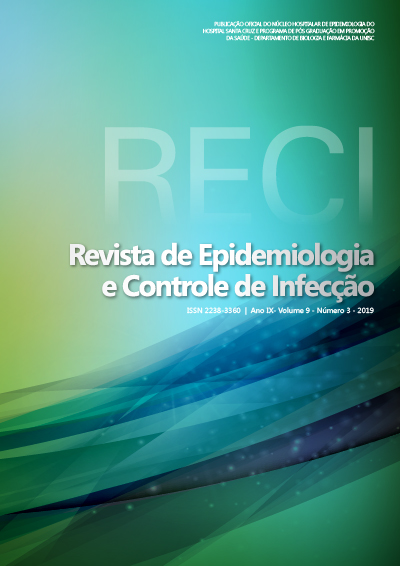Multidrug-resistant microorganisms in Intensive Care Units hands of health care workers
DOI:
https://doi.org/10.17058/reci.v9i3.12674Keywords:
Cross infection. Hand hygiene. Antimicrobial drug resistance.Abstract
Background and Objectives: The relation of multidrug-resistant organisms with nosocomial infections leave few expectations for the future, so this study aimed to identify the microorganisms present in the hands of professionals in intensive care units (ICU) and their role in hospital infections. Methods: Samples from the hands of adult and neonatal ICUs health professionals were collected using the method of sterile polyethylene bag followed by microbiological analyses. Results: A total of 51 samples were collected, 26 of the adult ICU and 25 of the neonatal ICU, of which 56.8% were nursing staff. Isolation of bacteria was carried out, in which approximately 60% of the volunteers presented contamination of the hands by microorganisms of the transient microbiota, and most of them resistant to β-lactams, including ESBL (54.5%), mainly Enterobacter spp., Klebsiella pneumoniae and Pseudomonas aeruginosa. Conclusion: These results demonstrate that microorganisms associated with nosocomial infections are present in the hands of health care professionals, and that hence, the hands hygiene is being deficient or neglected. To the reduction of nosocomial infection rates are needed several factors such as continuing education, monitoring of adherence to the practice of hand hygiene, maintenance, equipment installation and rational use of antibiotics.Downloads
Downloads
Published
How to Cite
Issue
Section
License
The author must state that the paper is original (has not been published previously), not infringing any copyright or other ownership right involving third parties. Once the paper is submitted, the Journal reserves the right to make normative changes, such as spelling and grammar, in order to maintain the language standard, but respecting the author’s style. The published papers become ownership of RECI, considering that all the opinions expressed by the authors are their responsibility. Because we are an open access journal, we allow free use of articles in educational and scientific applications provided the source is cited under the Creative Commons CC-BY license.


